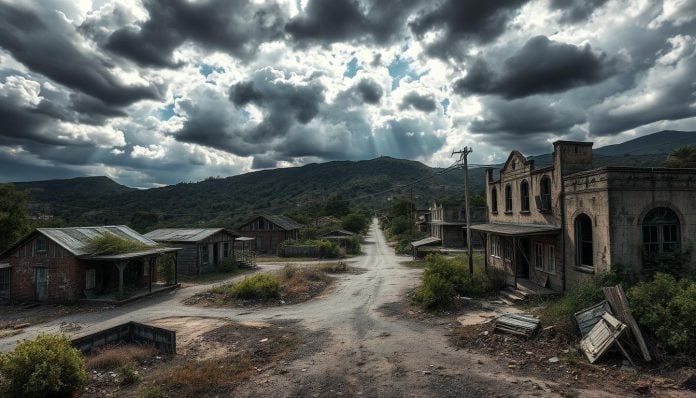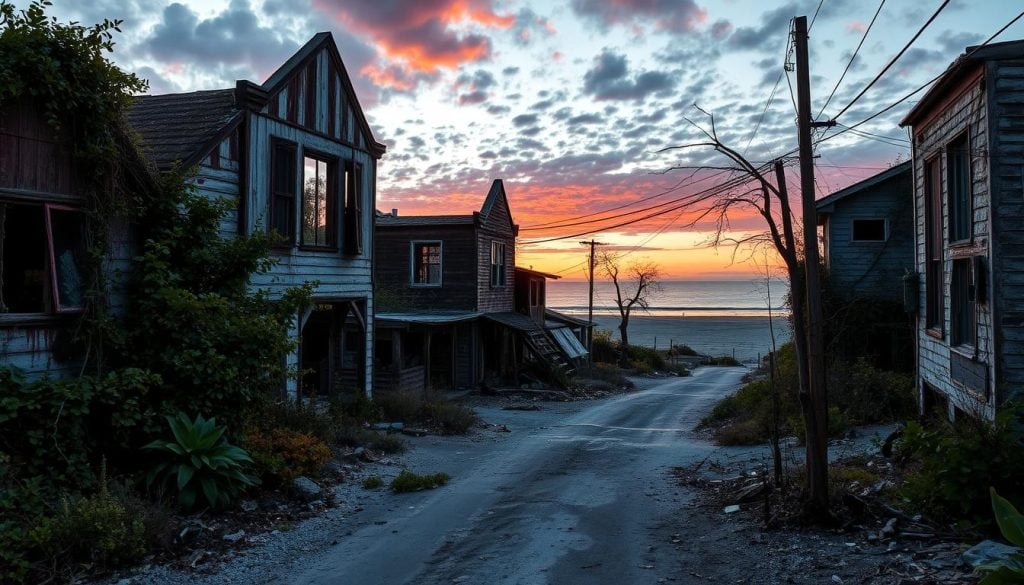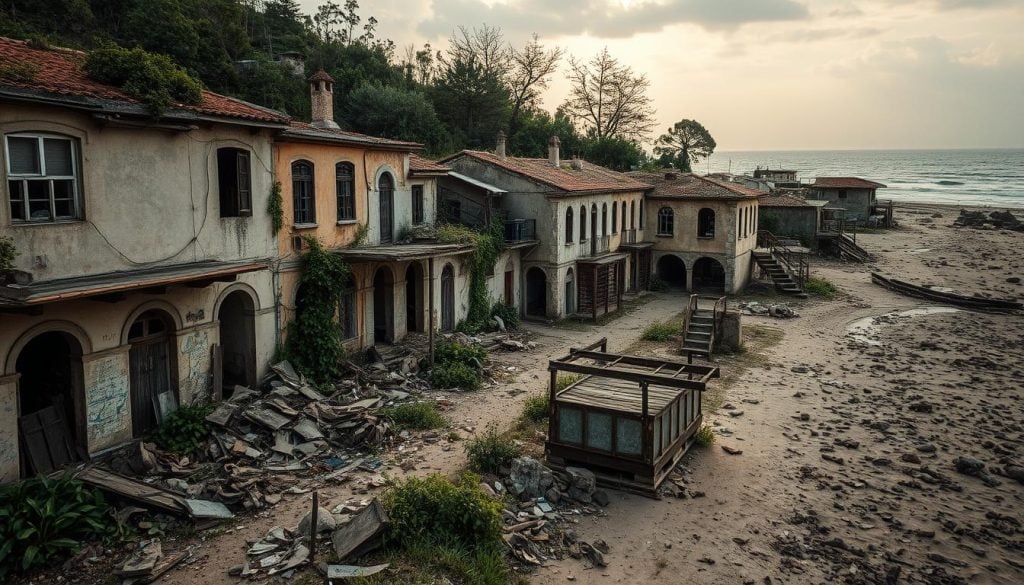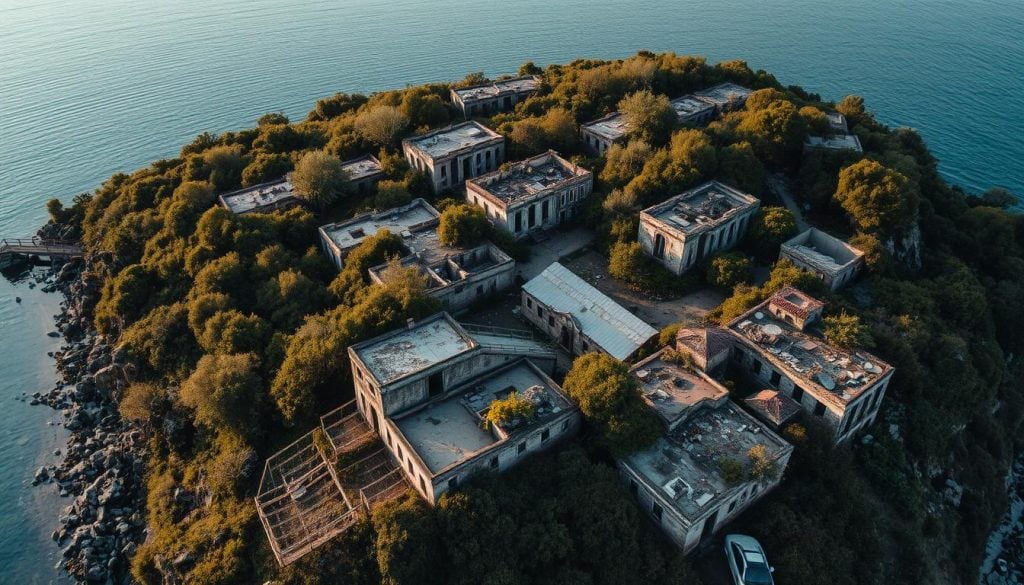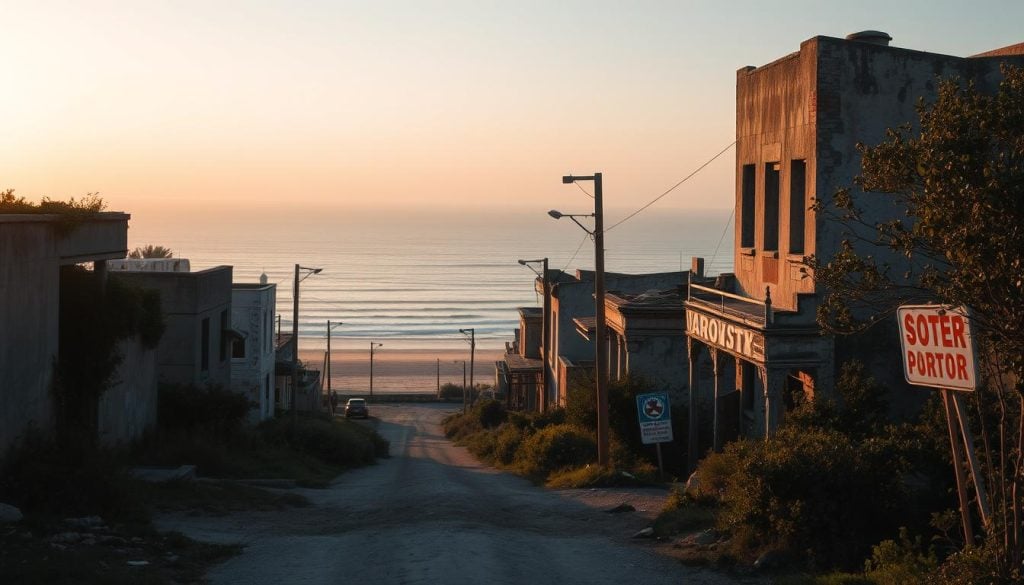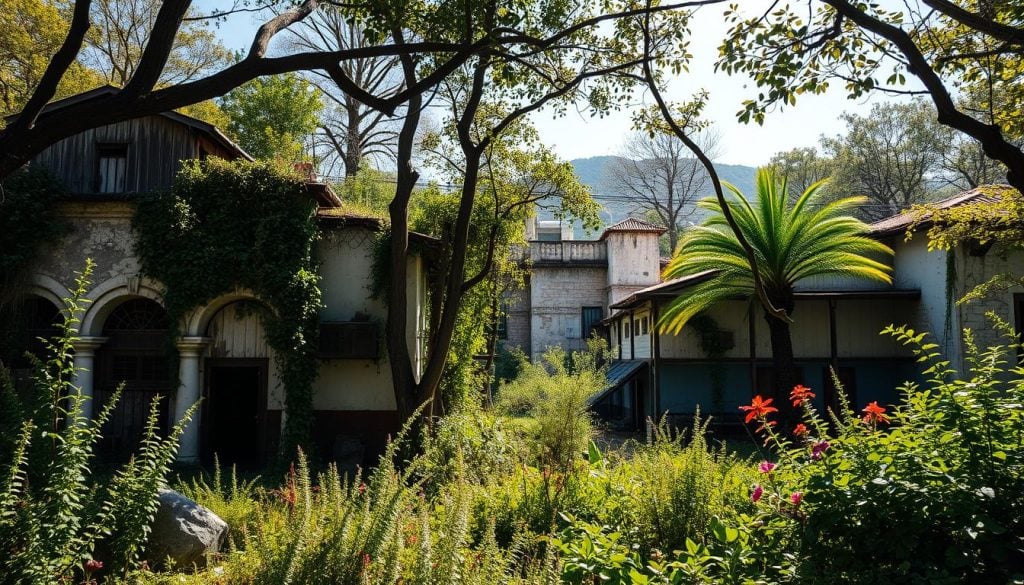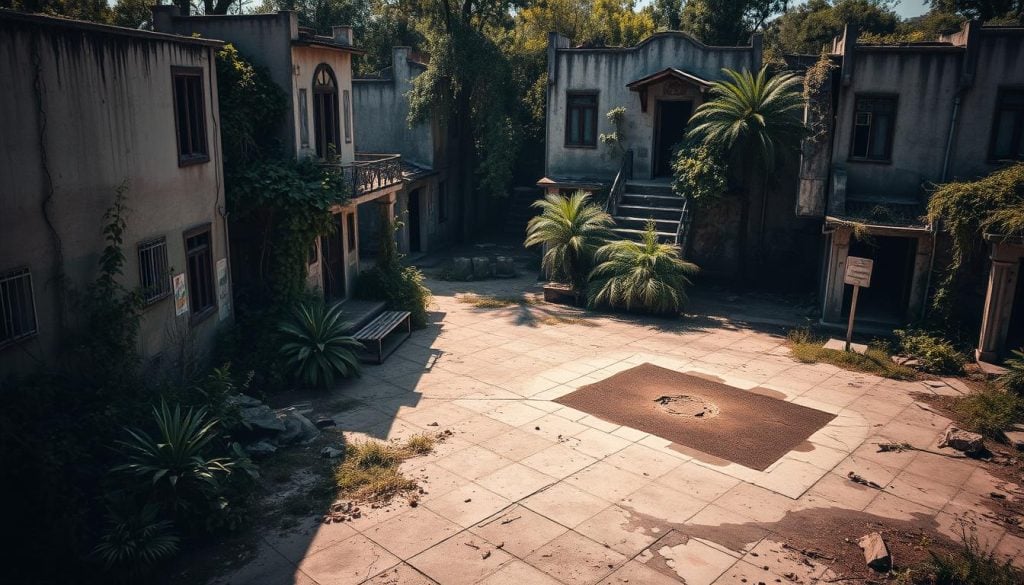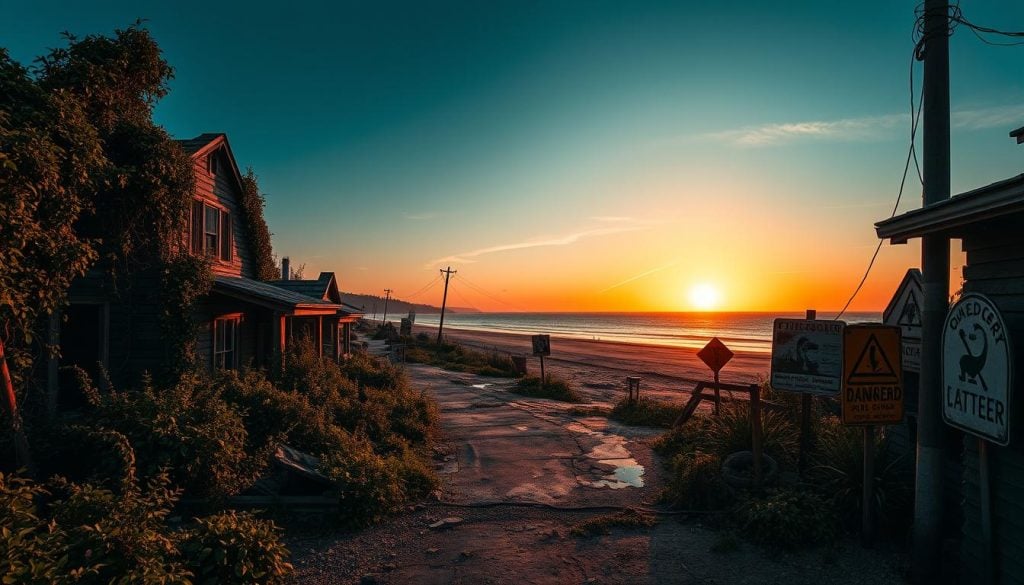What happens when tourism meets the memories of a city that once thrived, now marked by tragedy? You’re about to explore Varosha, an abandoned city in Cyprus. It’s a place where stories of those who lived there still linger.
As you think about visiting Varosha, you’ll face tough questions. These include the ethics of exploring a place with such a painful past. The reopening of Varosha raises big questions about who gets to tell their stories. It also makes us think about the impact of visiting a place filled with pain and longing.
Introduction to Varosha Ghost Town
Varosha ghost town is in Famagusta, Cyprus. It gives us a glimpse into the past. Once, it was a lively place with beautiful beaches and fancy hotels, called “the French Riviera of Cyprus.”
Many celebrities and tourists loved it. They came for the perfect Mediterranean getaway.
The Turkish invasion in 1974 changed everything. Varosha was left empty and forgotten. Its once-luxurious buildings now stand as haunting reminders of what was lost.
In 2020, Varosha reopened under Turkish Cypriot control. Now, people can visit again. But, there’s a debate about its future. Some want to bring back the old charm, while others think we should remember its past.
Historical Background of Varosha
Varosha’s history is filled with turmoil and displacement. It was once a lively resort town in Cyprus. But, the Cyprus conflict turned it into a symbol of loss.
In the 1960s, tensions rose, leading to the 1974 Turkish invasion. This event forced about 39,000 Greek Cypriots to leave their homes. They left behind a vibrant community.
For years, Varosha stood as a desolate ghost town. The United Nations tried to help its former residents return. But, their efforts were ignored, and the town fell into disrepair.
The reopening of Varosha in 2020 brought new questions. It raised issues about control and ownership in the ongoing Cyprus conflict. The town’s future is uncertain, showing the challenges of displacement and seeking peace.
| Year | Significant Event | Impact on Varosha |
|---|---|---|
| 1960 | Independence of Cyprus | Rise of intercommunal tensions |
| 1974 | Turkish invasion | Mass exodus of Greek Cypriots |
| 2000s | UN Resolutions | Calls for restoration ignored |
| 2020 | Reopening of Varosha | Renewed discussions on control |
Ethical Dilemma: Exploring the ghost town of Varosha: ethical considerations?
Varosha is a place filled with deep ethical questions. It’s a ghost town with a rich history but also a painful past. Visitors struggle with the mix of nostalgia and suffering, questioning the dignity of its former people.
Impact on Former Residents
The reopening of Varosha has big effects on its old residents. It forces them to relive painful memories. Some want to go back home, while others fear being seen as tourist attractions.
This creates a tough balance. It’s about making Varosha a tourist spot without forgetting its past.
Tourism vs. Commemoration
Tourism is now a big part of Varosha’s life. But it raises ethical questions. It can help the local economy but also turn the town’s suffering into a product.
The goal is to find a way to respect both tourism and remembrance. This way, visitors can learn from Varosha’s history while showing respect for its past.
The Unfolding Controversy Surrounding Varosha
The reopening of Varosha has sparked a big debate in Cyprus. People see it through different eyes, showing the complex issues at play. This ghost town’s revival is a big deal, with many opinions on what it means.
Political Implications of Reopening
The reopening of Varosha has big effects on Cyprus’s politics. Turkish Cypriots see it as a positive step, a chance to rebuild their heritage. They believe it’s a win that helps heal old wounds.
But Greek Cypriots are worried. They think it’s a bad move that could hurt their claims to the area. They fear it might make the Turkish occupation seem okay, adding to the tension between them.
It’s important to understand the politics behind Varosha’s reopening. The debate is not just about who owns the land. It’s about who gets to decide, who gets to stay, and who gets to remember history. Each side has a story of loss, making peace talks harder.
| Perspective | Views on Reopening | Key Issues |
|---|---|---|
| Turkish Cypriots | View reopening as a victory, fostering renewal | Revitalization of cultural heritage |
| Greek Cypriots | Perceive reopening as a dangerous provocation | Legitimization of occupation; national identity concerns |
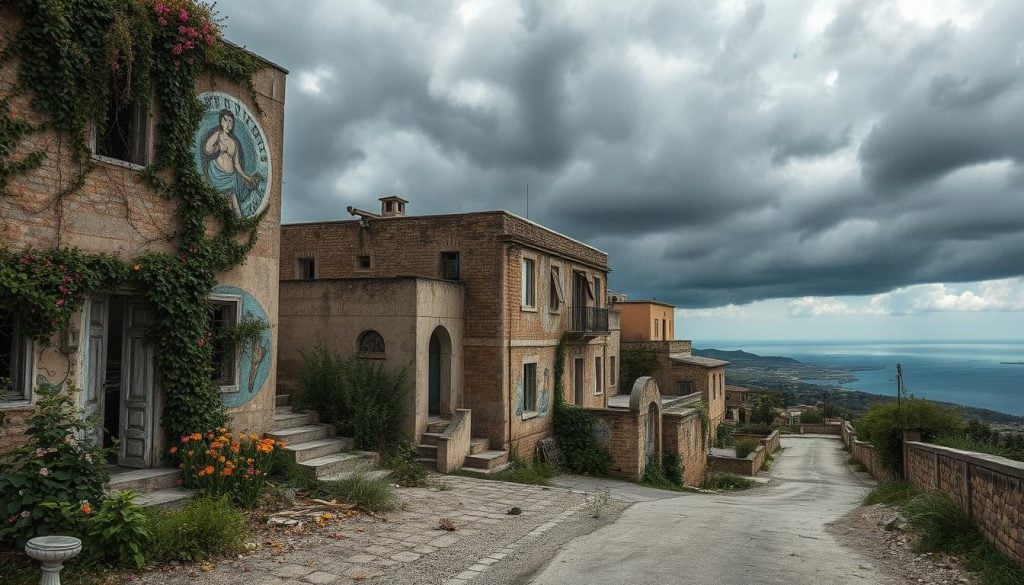
Tourism Trends in Varosha
Since Varosha reopened, more tourists are coming. People from all over are curious about this once-abandoned town. They want to learn about its history and culture.
Visitor Statistics Since Reopening
Over one million tourists have visited Varosha since it reopened. This shows how much people are interested in its history. Here are the visitor numbers:
| Year | Number of Visitors | Percentage Increase |
|---|---|---|
| 2021 | 300,000 | N/A |
| 2022 | 750,000 | 150% |
| 2023 | 1,200,000 | 60% |
Guided Tours and Visitor Experiences
Guided tours are now a favorite way to see Varosha. They offer a deep dive into the town’s history. You’ll hear stories from those who lived there.
- Historical Events: Learn about key moments in Varosha’s history.
- Architectural Highlights: Discover the significance of its buildings.
- Cultural Narratives: Hear tales from former residents.
Emotional Responses of Former Residents
Visiting Varosha can stir up strong feelings for those who lived there. The area, once full of life, now reminds them of loss and leaving home. People feel a mix of nostalgia and sadness, trying to make sense of their past and present.
Anxiety and Anger over Viewing Their Past
Going to Varosha can make former residents very anxious. Seeing the ruins of their homes brings anger and sadness. Each broken building reminds them of what’s gone.
Seeing tourists take pictures makes things worse. It feels like a betrayal of their memories. The difference in how tourists see Varosha and how former residents feel shows we need to understand and be kind.
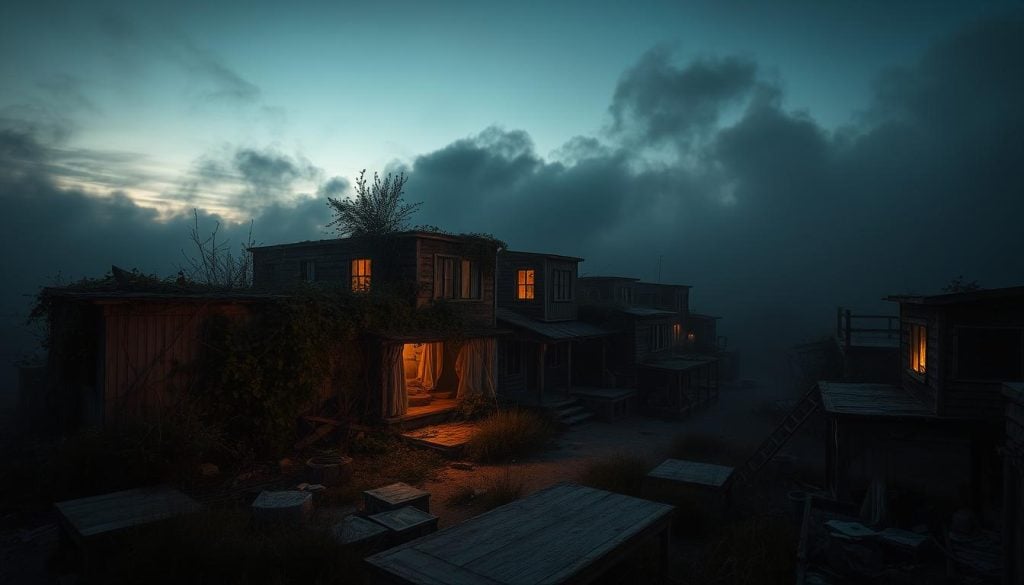
Environmental Considerations and Preservation Efforts
Nature is slowly taking back Varosha, with plants covering old buildings and streets. This natural recovery shows the environment’s strength. Yet, it makes preserving Varosha’s history a big challenge.
Nature’s Reclaiming of Varosha
The growth of plants in Varosha is both beautiful and hard to preserve. Areas once busy with people now show a mix of nature and old civilization. This change is a sign of nature’s return but also makes saving Varosha’s history harder.
Preservation Challenges Amid Ruins
Trying to save Varosha faces many obstacles. Keeping the site’s integrity is key. Challenges include:
- Restoration Tactics: It’s tough to use modern methods while keeping the site’s true history.
- Funding and Resources: Getting enough money for conservation is a big worry.
- Environmental Considerations: It’s important to handle restoration without harming nature’s takeover.
The mix of saving Varosha and nature’s move is a special story. Your thoughts on this can help shape how we talk about this historic place.
| Challenge | Description |
|---|---|
| Restoration Tactics | Finding a balance between modern techniques and the site’s historical authenticity. |
| Funding and Resources | Ensuring sufficient financial support for ongoing conservation initiatives. |
| Environmental Considerations | Addressing ecological impacts while preserving natural reclamation processes. |
Varosha’s Representation in Media and Culture
Varosha’s haunting images have caught the attention of many in media, from films to photos and news. Once a lively tourist spot, it now stands as a symbol of decay and nostalgia. This change in image greatly affects how people see Varosha, making it more than just a ghost town.
Filmmakers and photographers use Varosha’s empty buildings and wild landscapes to stir emotions. The town’s story of resilience and memory touches many. This is seen in documentaries and art that delve into human experiences during tough times.
Varosha keeps drawing attention in cultural talks, sparking discussions on memory, history, and identity. Its role in media reminds us of the past, influencing talks worldwide.
Travel Tips for Visiting Varosha
Planning your trip to Varosha is key to a great experience. The best times to go are spring and fall. These seasons offer mild weather, making your visit more enjoyable.
Best Times to Visit Varosha
April to June and September to November are the best months to visit. These times are cooler, avoiding the summer heat. You’ll also find fewer tourists, giving you a closer look at Varosha’s history.
What to Expect While Touring the Ghost Town
Varosha offers a mix of beauty and history. You’ll see sandy beaches and ruins that tell stories of the past. Buildings with faded signs and peeling paint hold secrets of lives once lived.
Some areas are off-limits for safety reasons. So, focus on the parts you can visit. Guided tours are a great way to learn about Varosha’s past. They offer insights and respect for its history.
Conclusion
Exploring Varosha teaches us about the tough issues of displacement, memory, and tourism. As you walk through this ghost town, you see its deep meaning. It’s a place stuck in time and a symbol of strength.
Every broken wall and empty street brings back memories of those who lived here. This makes us feel the heavy emotions of those who lost their homes.
Visiting Varosha with care can help the ongoing talks about it. Recognizing its complex history and current state can ease the anger and sadness of those affected. It’s important to respect both the past and the dreams for a better future.
Varosha’s story is more than just a tourist spot. It’s about learning, remembering, and maybe even rebuilding. By understanding its history, we can truly value its role in the future. This way, we can honor its significance as a beacon of hope.

































